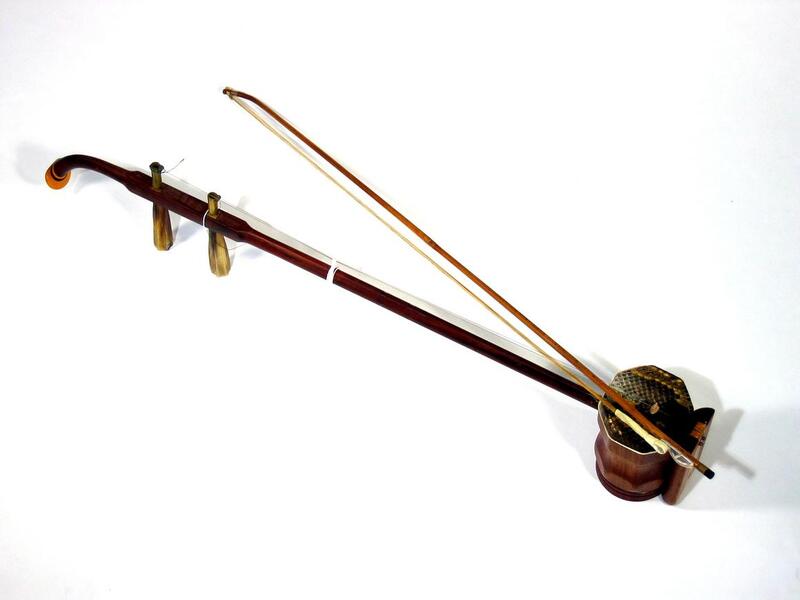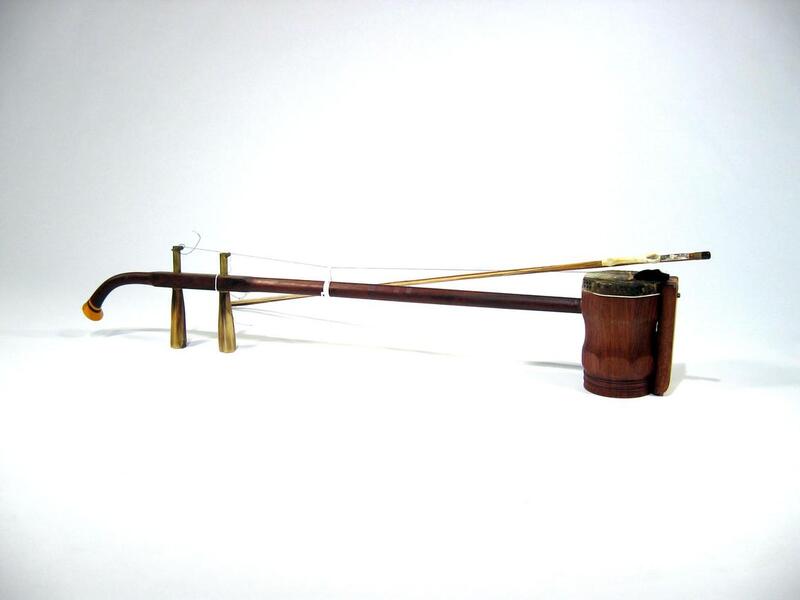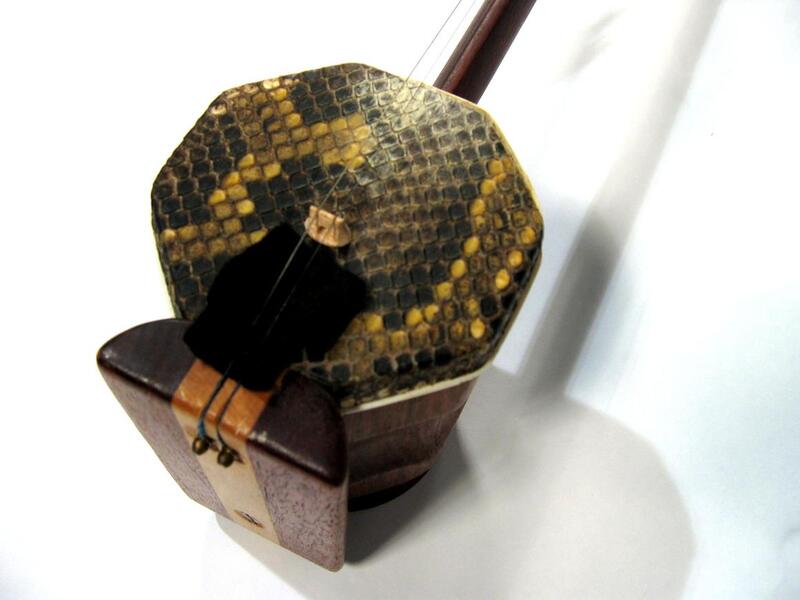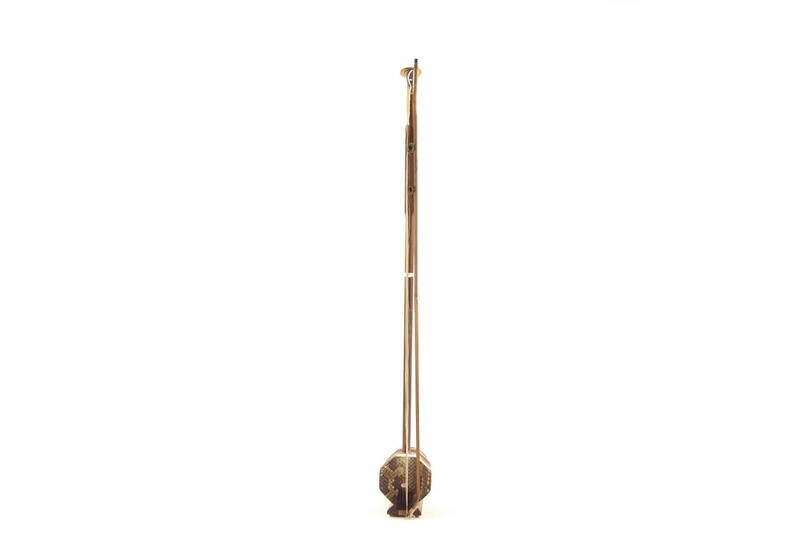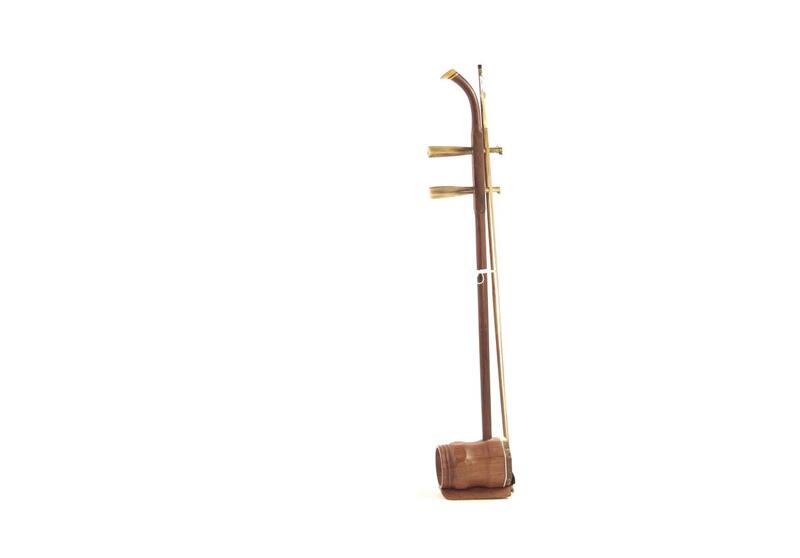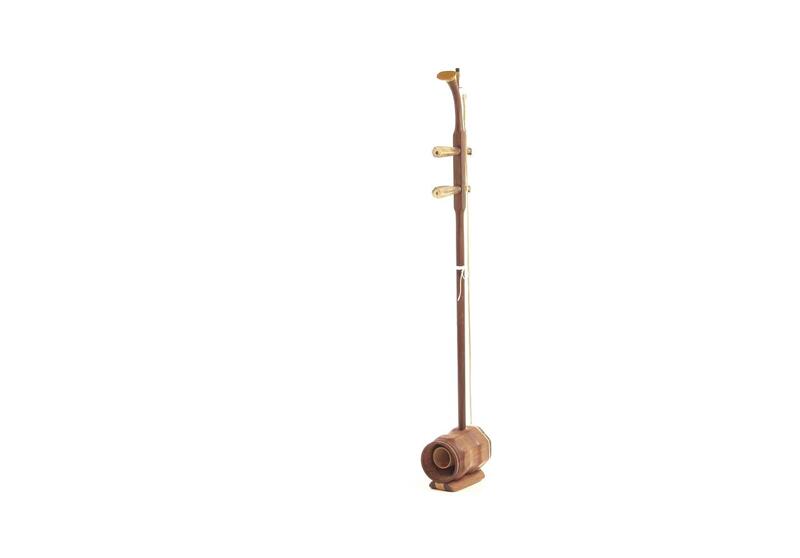Erhu
Title
Video
Physical description
Erhu is a medium-high ranged Chinese two-stringed fiddle. The structure of the modern erhu was regularized in the 1920s by Liu Tianhua (1895-1932), the pioneering musician and composer in modern Chinese erhu and pipa music. Erhu consists of a body (qin tong), a shaft (qin gan), two tuning pegs (xuan zhou), a tight loop of string (qian jin), and a tiny bridge (xuan ma). Erhu’s body (13 cm long) can be made of padouk wood (hong mu), red sandalwood (zi tan), or ebony wood (wu mu). Its shape is usually hexagonal, with round or octagonal regional variations. Its front (8.8 cm in diameter) is covered with snakeskin, while the back is closed with a piece of pierced wood or bone (yin chuang). The shaft (78 cm long) is made of the same wood as the body. Its top is called the head of the instrument (qin tou), and is either carved in the form of a dragon’s head or a half moon. Two tuning pegs are set in the upper section of the shaft, while the lower end of the shaft is fixed onto the body. Qian jin is made of a tight loop of soft silk string which encircles the shaft and strings. Together with the bridge, qian jin sets the appropriate vibrating length of the strings (38 or 39 to 41 cm). Erhu’s bow is made of reed (jiang wei zhu, 76 cm) strung with horsehair or nylon. The bow hairs are inserted between the two strings that are made of silk (in the past), steel, or steel wrapped with nylon.
Historical background
Today’s erhu probably evolved from several different kinds of stringed instruments. Erhu was historically known as huqin (lit. “barbarian’s stringed instrument”), indicating its northern association. Hu was a derogatory word for northern ethnic tribes. The term huqin was first mentioned in the Song dynasty (960-1279). Earlier on, the reference to ji qin first appeared in the Tang dynasty (618-907). Ji Kang (223-263), a famous literati musician, was attributed as its creator. Later, the reference to xi qin, named after a northern nomadic tribe Xi, first appeared in Song dynasty (960-1279). These two instruments were both first described as plucked string instruments, and later as having two strings and being played by pressuring the strings with a strip of bamboo, suggesting that the earliest Chinese bowed instruments were derived from plucked stringed instruments. These various instruments were perhaps assimilated over a long historical period. Eventually in the Yuan dynasty (1279-1368), under the Mongolian’s rule, both the description of huqin in writing and the portrayal of huqin in painting came to resemble today’s erhu. In the Ming dynasty (1368-1644), qian jin appeared and in the Qing dynasty (1644-1911), a number of variants of huqin came into use, such as jing hu (Peking opera two-stringed fiddle). Huqin, therefore became a generic term for a very large number of bowed instruments.
It is not known for sure when and how the term erhu appeared. It most possibly originated in the early twentieth century when Liu Tianhua composed 10 erhu solo pieces, using some Western classical music compositional techniques. Liu Tianhua’s effort left a significant impact on modern Chinese music history, and especially on erhu. In the twentieth century, equated to violin, erhu became a primary instrument for solo, duo, or concerto forms, and the leading instrument in both small regional ensembles and the modern Chinese instrumental orchestra.
Playing technique
In playing, erhu is held upright by the left hand, its body sits on the player’s left thigh. The fingers of the left hand stop the strings, while the right hand and arm operate the bow. By pushing the wood of the bow outward or pulling the bow hair inward with right hand fingers, the player produces sound from one of the two strings. Bowing techniques include long bow (chang gong), short bow (duan gong), tremolo (chan gong), and others. In modern erhu performance, the left hand moves to several positions. Left hand techniques, which often distinguish the special sound characteristics of erhu, include vibrato (rou yin), glissando (hua yin), appoggiatura (da yin), and others.
Notation
Erhu does not have its own notational system. When accompanying singing and opera performance before the mid twentieth century, erhu musicians played from memory, with some degrees of improvisation on melodic ornamentations. In a few cases, gong che pu (note name notation) was used for small folk ensemble repertory, whose instruments included erhu. Today, almost all erhu performers use cipher notation, which has been widely adopted by Chinese traditional instrumentalists since the mid twentieth century. Conservatory trained musicians sometimes use staff notation as well, especially when performing contemporary avant-garde pieces.
Tuning
The two strings of erhu are tuned in a fifth, most often with d1 and a1 or c1 and g1, sometimes g and d1 or a and e1, with a range of three octaves (d1 to d4).
Geography
Classification
Ensemble
Materials
Bibliography
Jonathan Stock, 1996. Musical Creativity in Twentieth-Century China: Abing, His Music, and Its Changing Meanings. Rochester, NY: University of Rochester Press.
Terrence Liu, 2002. "Erhu." In The Garland Encyclopedia of World Music, Vol. 7. East Asia: China, Japan, and Korea, ed. by Robert Provine, Yoshihiko Tokumaru, and J. Lawrence Witzleben, New York: Routledge, 175-8.
Su Zheng, 2002. "Musical Instruments." In The Garland Encyclopedia of World Music, Vol. 7. East Asia: China, Japan, and Korea, ed. by Robert Provine, Yoshihiko Tokumaru, and J. Lawrence Witzleben, New York: Routledge, 79-83.
